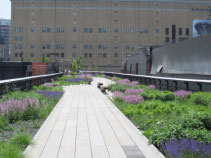Work on High Line Project Uplifts SOPH Student
Posted in Learning Experiences, People on July 21 2009, by Plant Talk
 |
Ashley Burke is a second-year student in the School of Professional Horticulture. She is doing her required six-month internship at the High Line in Manhattan, a recently completed elevated public park built on a former rail bed. The School’s internship program is designed to allow students to synthesize and apply what they’ve learned, expand their skills by providing further training in a professional horticulture venue, and expose them to the multiple facets of the field. Ashley sent us this report. |
 Interning at the High Line, a park on the Lower Westside of Manhattan that opened on June 9, has given me an unparalleled opportunity to observe and learn about how a city park is created.
Interning at the High Line, a park on the Lower Westside of Manhattan that opened on June 9, has given me an unparalleled opportunity to observe and learn about how a city park is created.
I began working at the park in mid-April and as such, have been exposed to various elements of the process. Some of my responsibilities have included compiling a master plant list; verifying what has been planted; creating plant identification cards to be used by the public, with plant names, cultural information, native range, and where it is located in the park; and even selecting horticulture tools. Of course, I also had hands-on plant work: The week before opening, we raced against time to weed, water, and prune to get the park ready for visitors.
I also worked extensively with the plans that were drawn up by the landscape architects, field operations, and the landscape designer, Piet Oudolf (who co-designed the current Seasonal Walk at The New York Botanical Garden), and this has allowed me to familiarize myself with the plants being used. Part of this has been to check that each plant species is properly identified, the name is spelled correctly, and that the plants are located where they are indicated on the plan. Through my experiences, I am learning that one cannot design properly without being able to identify the materials one works with.
Though I am a horticulturalist at heart, now I’ve got a new passion—design. The mass plantings of native species such as Pycnanthemum muticum (mountain mint), Liatris pycnostachya (prairie blazing star), Echinacea pallida (purple coneflower), and Bouteloua curtipendula (side oats grama) mixed with more traditional perennials such as Astilbe ‘Visions in Pink’ and even bulbs such as Eremurus stenophyllus (foxtail lily) and Allium obliquum (twisted-leaf garlic) has inspired me to familiarize myself with a whole new palette of plants.
The fluid and organic nature of the planting beds contrasts so beautifully with the hard, gritty edge that is so characteristic of New York City. I feel so lucky to be a part of this project and look forward to each day.
The School of Professional Horticulture is now accepting applications for the Class of 2012. Application deadline is August 15.


I am a Landscape architect … in training. I just finished the undergraduate program at Philadelphia University and am currently interning at Olin, a landscape architecture firm in Philadelphia. I was wondering what type of maintenance you have to do on the highline to keep the wildflowers healthy and blooming. What is the rough budget of the maintenance and how often are the gardeners/ horticulturalists/ volunteers weeding? I’m trying to design a planting plan for a project we’re working on and was looking at the highline for precedence. Any information would help. I’m glad your interests are slowly incorporating design. I’m the opposite, education in design and becoming more and more curious/ interested in horticulture. Thanks, Laura